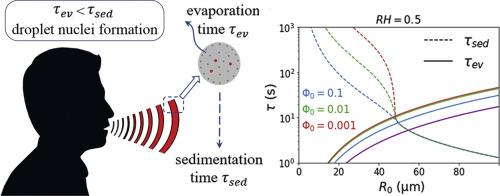Current Opinion in Colloid & Interface Science ( IF 8.9 ) Pub Date : 2021-05-29 , DOI: 10.1016/j.cocis.2021.101471 Majid Rezaei 1 , Roland R Netz 1

|
Airborne transmission is considered as an important route for the spread of infectious diseases, such as severe acute respiratory syndrome coronavirus 2 (SARS-CoV-2), and is primarily determined by the droplet sedimentation time, that is, the time droplets spend in air before reaching the ground. Evaporation increases the sedimentation time by reducing the droplet mass. In fact, small droplets can, depending on their solute content, almost completely evaporate during their descent to the ground and remain airborne as so-called droplet nuclei for a long time. Considering that viruses possibly remain infectious in aerosols for hours, droplet nuclei formation can substantially increase the infectious viral air load. Accordingly, the physical-chemical factors that control droplet evaporation and sedimentation times and play important roles in determining the infection risk from airborne respiratory droplets are reviewed in this article.
中文翻译:

病毒通过呼吸道飞沫传播:飞沫蒸发和沉降的影响
空气传播被认为是严重急性呼吸系统综合症冠状病毒2(SARS-CoV-2)等传染病传播的重要途径,主要取决于飞沫沉降时间,即飞沫在空气中停留的时间在到达地面之前。蒸发通过减少液滴质量来增加沉降时间。事实上,根据其溶质含量,小液滴在下降到地面的过程中几乎可以完全蒸发,并作为所谓的液滴核在空中停留很长时间。考虑到病毒可能在气溶胶中保持传染性数小时,液滴核的形成会大大增加传染性病毒空气载量。因此,


























 京公网安备 11010802027423号
京公网安备 11010802027423号